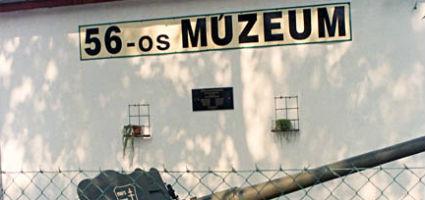2024. April 27. Saturday
Museum 1956 - Kiskunmajsa
 |
Address: 6120, Kiskunmajsa Marispuszta 244.
Phone number: (77) 581-409
E-mail: pongratz.odon@56-osmuzeum.hu
Opening hours: Mon-Sat 9-17, Sun 13-17
|
The first and the last museum up to now on '56 was inaugurated in Kiskunmajsa on 14, March, 1999. The founder Pongrátz Gergely, the legendary commander-in-chief of Corvin lane, created a memory for the heroes of 1956. After the failure of the revolution of 1956, Gergely Pongrátz left the country on 28, November 1956. He did not return until 1990. He was taken off the list of the unwanted in December 1989. If he had come back before he would have been executed. He published a book titled "Corvin Lane 1956" in 1982. He put down the real story of the revolution.
After his return, he did everything he could to help his comrades in difficult situation. He found a home for the ex soldiers of '56 in need in the barracks of Mátyásföld. He created a museum here as well. Unfortunately, the museum was attacked by untrue methods and Pongrátz had to move the museum to Kiskunmajsa.
The museum is 5 kms from the town on the road to Szeged. His comrades donated artworks, relics, photos, documents. The early arsenal can be seen beginning from the Molotov cocktail to the T-55 tank. The collection constantly develops from the donations of people.
The chapel built by Gergely Pongrátz for the martyrs of '56 was ordained on 29, June 2002. György Csete, Kossuth Prize winner architect, designed the chapel. Gergely Pongrátz did not receive any help from the State; the amount was collected by donations of true people.
The church has an oval shaped base. With its lame tower, it symbolizes the suppressed revolution. A marble plate in the chapel preserves the names of the 338 known victims, their day of birth and execution. Two of the marbles were left for the unknown heroes.
The chapel is situated on the territory of the primacy of Kalocsa. Its patron saint is Saint John of Capistran who set off to fight the Turkish from this region. The statue is the work of Ferenc Polyák. It is erected on one side of the chapel. The carved statue of Christ on the other side is the work of Lajos Molnár. The statue of Christ grows out of the roots of a giant tree. The message is clear: even if a tree is cut its roots may sprout hundreds of years later. This is what the desire of the Hungarians to be free like for which the nation is able to pull together if necessary.
On 19, August 2002 Balázs Bábel ordained the artwork of Rimantas Zinkevicius, a 'Sitting Christ' made of oak. It is located in front of the chapel.
The chapel is the location of service every last Sunday of the month and every religious celebration at 4 o'clock pm.
After his return, he did everything he could to help his comrades in difficult situation. He found a home for the ex soldiers of '56 in need in the barracks of Mátyásföld. He created a museum here as well. Unfortunately, the museum was attacked by untrue methods and Pongrátz had to move the museum to Kiskunmajsa.
The museum is 5 kms from the town on the road to Szeged. His comrades donated artworks, relics, photos, documents. The early arsenal can be seen beginning from the Molotov cocktail to the T-55 tank. The collection constantly develops from the donations of people.
The chapel built by Gergely Pongrátz for the martyrs of '56 was ordained on 29, June 2002. György Csete, Kossuth Prize winner architect, designed the chapel. Gergely Pongrátz did not receive any help from the State; the amount was collected by donations of true people.
The church has an oval shaped base. With its lame tower, it symbolizes the suppressed revolution. A marble plate in the chapel preserves the names of the 338 known victims, their day of birth and execution. Two of the marbles were left for the unknown heroes.
The chapel is situated on the territory of the primacy of Kalocsa. Its patron saint is Saint John of Capistran who set off to fight the Turkish from this region. The statue is the work of Ferenc Polyák. It is erected on one side of the chapel. The carved statue of Christ on the other side is the work of Lajos Molnár. The statue of Christ grows out of the roots of a giant tree. The message is clear: even if a tree is cut its roots may sprout hundreds of years later. This is what the desire of the Hungarians to be free like for which the nation is able to pull together if necessary.
On 19, August 2002 Balázs Bábel ordained the artwork of Rimantas Zinkevicius, a 'Sitting Christ' made of oak. It is located in front of the chapel.
The chapel is the location of service every last Sunday of the month and every religious celebration at 4 o'clock pm.
|
Programmes
|
|
|
Permanent exhibitions
|
|